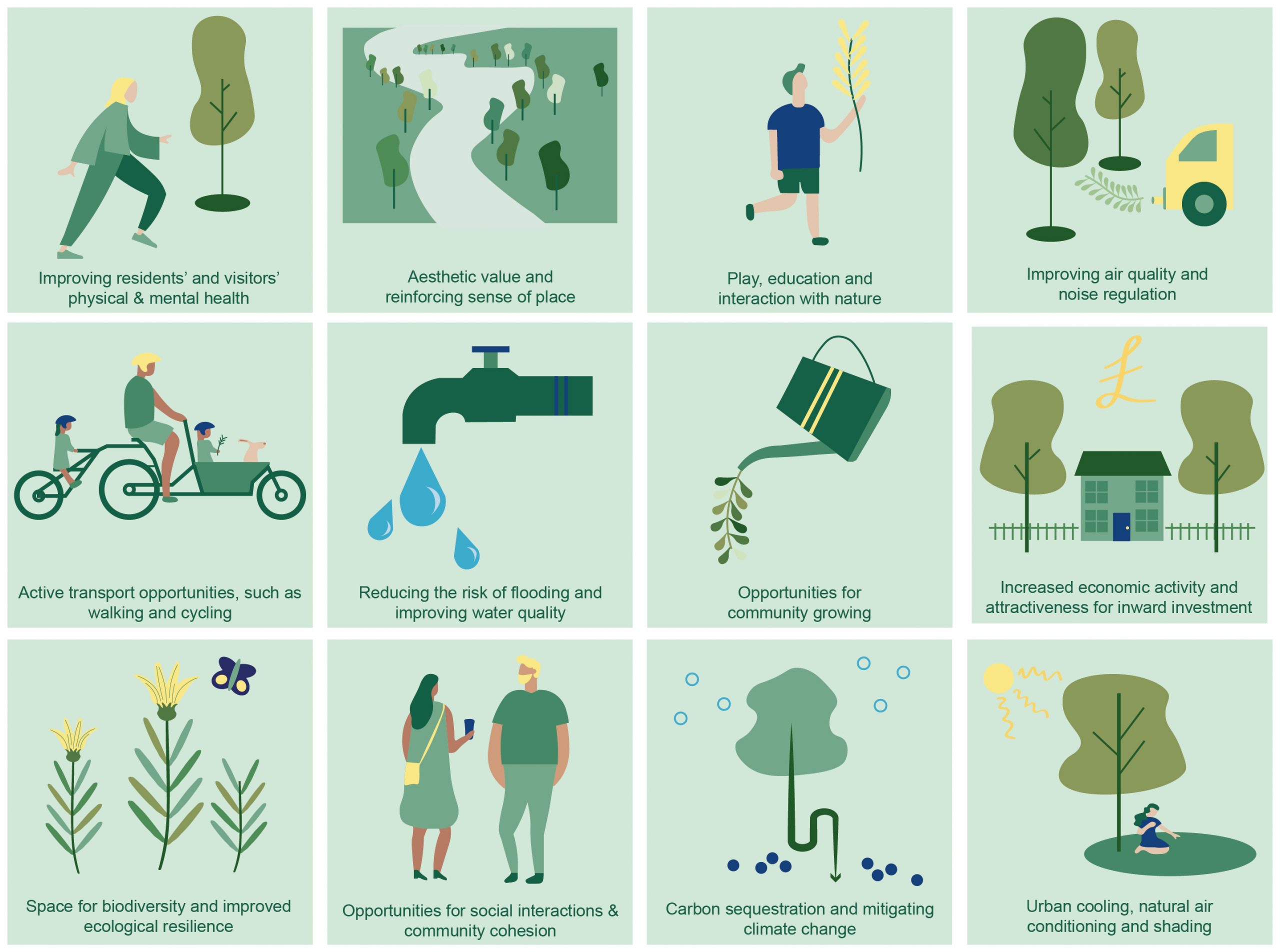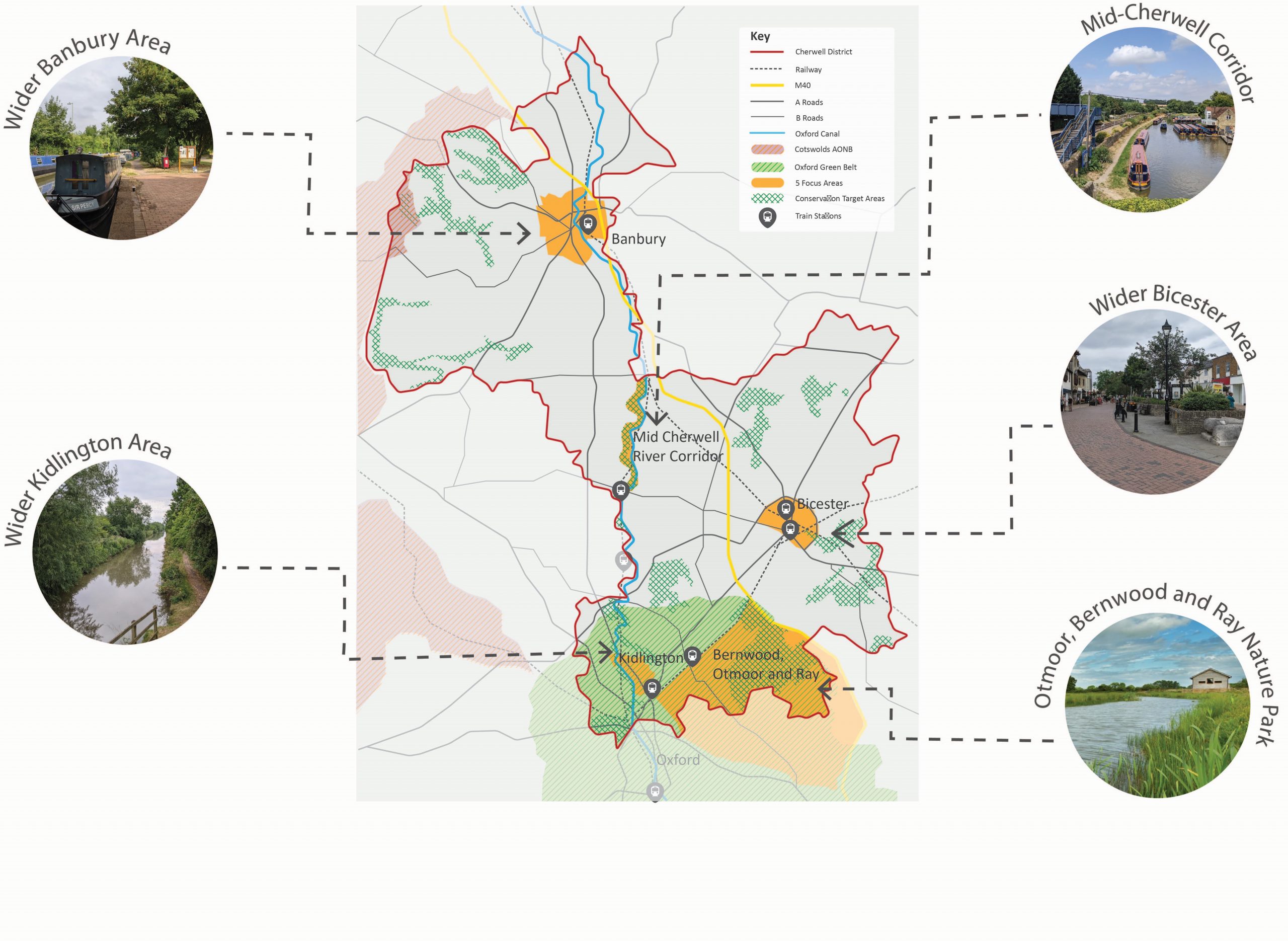About the Strategy
What is Green and Blue Infrastructure?

Green and Blue Infrastructure (GBI) refers to the network of green and blue spaces that surround and run through our towns and cities. GBI helps connect people, wildlife and nature.
GBI can include large green spaces like National Parks, Country Parks, farmed landscapes or river corridors. It can also include private gardens, allotments, hedges, street trees, roadside green verges, or footpaths. But GBI is not about individual assets – more important are the connections between those assets and the functions they provide.
Crucially, GBI should form a strategic network of high-quality green spaces and other natural features, which offer quality of life benefits for communities. It should thread through and around the built environment and connect the urban area to its wider rural hinterland.
Unlike grey infrastructure, such as drainage pipes which have a single function, GBI has many functions. These include recreation, removing water pollution, providing homes for wildlife, providing flowers for bees and other pollinators and helping to keep urban areas cool.
Why is this Strategy being developed?
In 2015 Cherwell adopted its existing Local Plan, which provides a framework for growth across the District up to 2031.
At the time of developing this GBI Strategy, Cherwell’s Local Plan is being updated. The new plan (the Cherwell Local Plan Review) will cover the period up to at least 2040 and is being prepared against the backdrop of a rapidly changing national context – including a response to the climate emergency and a renewed focus on biodiversity and nature networks. It is important that the new Local Plan reflects this new reality.
The three over-arching themes for the new Local Plan are:
- Maintaining and Developing a Sustainable Local Economy
- Meeting the Challenge of Climate Change, and Ensuring Sustainable Development
- Building Healthy and Sustainable Communities
Consultation responses to the emerging Local Plan have highlighted strong support for securing biodiversity net gain (BNG), the protection and enhancement of the natural environment, and the desire to strengthen and extend GBI – including in town centres.
Against this background, the objectives of this Green and Blue Infrastructure (GBI) Strategy are to:
- Bring together all existing information on Green and Blue Infrastructure (GBI) in Cherwell in one place.
- Act as an evidence base for the emerging Local Plan – including informing allocations and site-specific requirements.
- Identify priorities for investing in the GBI network to help best direct funding streams.
Once identified, these priorities will be taken forward by a range of partners across the District.
A further key aim of this Strategy is to identify the value contributed to Cherwell by GBI, as detailed below.
How does Green and Blue Infrastructure (GBI) add value?
Historically, Green and Blue Infrastructure has been treated within the planning system as a cost. However new approaches – such as the ‘natural capital’ approach – have helped to better understand the tangible value of investment in GBI.
A natural capital approach considers the value of the natural environment for people and the economy. It is an important part of a wider move to better understand ‘inclusive wealth’ – as set out in the Dasgupta Review commissioned by the government in 2019.
The UK’s Planning Practice Guidance (PPG) states that:
Green infrastructure is a natural capital asset that provides multiple benefits, at a range of scales. For communities, these benefits can include enhanced wellbeing, outdoor recreation and access, enhanced biodiversity and landscapes, food and energy production, urban cooling, and the management of flood risk. These benefits are also known as ecosystem services.
This value is largely made up of:
- Provisioning services – products from nature such as food, water, energy and materials. This includes agriculture, water extraction, renewable energy and mineral extraction.
- Regulating services – services helping to maintain the quality of our environment, such as carbon sequestration to remove greenhouse gases, parks and blue spaces to cool, and vegetation to remove air pollutants.
- Cultural services – these are non-material benefits people obtain from natural capital, such as tourism, recreation and aesthetic experience.

In fact, the Office For National Statistics now produces a set of Natural Capital accounts. These estimate the financial and societal value of natural resources in the UK. In 2019, they estimated that the stock of the UK’s natural capital is worth £1.2 trillion.
Geographically, Cherwell is located within the wider Ox-Cam Arc. Within the Ox-Cam Local Natural Capital Plan, natural assets are estimated to provide the following across the Arc as a whole:
- £763 million of value in agricultural production.
- £747 million of value for water quality and supply.
- £507 million in value for recreation (from 168 million visitors).
- £70 million of value for climate regulation (by sequestering carbon in habitats like woodland and peatland).
The findings of the Oxfordshire Natural Capital work have been integrated into this GBI Strategy. These are interpreted for Cherwell as a District within the Cherwell District Natural Capital Report (2021).
One of the next steps for Cherwell’s Natural Capital workstreams is the development of a Natural Capital Investment Plan. It is important that ongoing GBI work is fully integrated with ongoing Natural Capital work.
What are the 5 Focus Areas highlighted within the Strategy?

In order to focus efforts to improve Cherwell’s GBI network, five ‘Focus Areas’ were identified in the early stages of this Strategy’s development. These areas were ‘tested’ at a virtual round table of key stakeholders in May 2022 (see Appendix 2 for further detail).
Three of these Focus Areas concentrate on Cherwell’s three main built-up areas, which are undergoing significant change from development. This means that the GBI network in these areas will require significant investment to accommodate this change, while providing gains to the local environment. They are:
- The wider Banbury urban area.
- The wider Bicester urban area.
- The wider Kidlington urban area.
In addition, two further Focus Areas were identified. These were identified around strategic GBI assets or corridors, or in areas where partnerships had been established to progress landscape-scale recovery initiatives which meet the objectives of this Strategy. They are:
- The Bernwood, Otmoor and Ray Area.
- The Mid Cherwell River Corridor.